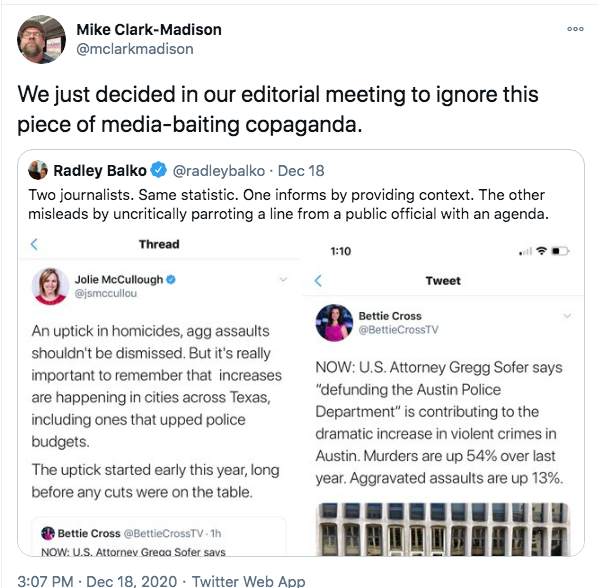Their defunding in 2006 was a mixed outcome. Grits was indifferent to modestly appreciative about the drug-court money, opposed to the border-security initiative, but pleased as punch that this network of 700 officers lost its funding (though there weren't nearly that many by the time Perry pulled the plug). Of officers whose positions were eliminated, Grits' recollection is that about 150 or so were repatriated to their old agencies. But many had been hired on contract and just lost their jobs. (A few of those guys were quite mad at me and others involved in the campaign for several years afterward.)
Still, in the wake of how the politics of police accountability has shifted in 2020, with emphasis migrating from oversight and training to "defunding," it's worth recalling this successful "defund" campaign from the past. What did defunding Texas drug-task forces look like in actual, messy, real-world politics?
In a nutshell: Extreme, persistent misconduct by a handful of agencies, coupled with examples of discriminatory enforcement by most of them, resulted first in expanded oversight, then in defunding and abolition when oversight proved ineffective.
The advocacy campaign began with legal observers attending court hearings of drug defendants from the Tulia drug stings in 1999 (shout out to Jeff Frazier and Will Harrell). Reform legislation was passed in 2001 and 2003, then the task forces were placed under DPS control in 2005. Gov. Perry defunded them in 2006, the year before he signed the state's landmark probation reforms. So start to finish, it was a seven-year campaign; defunding the task forces was an overt goal for roughly five of them.
The various stages of this process involved all three branches of government: Courts identified problems through civil litigation and criminal prosecutions of errant police officers, accompanied by a wave of media coverage, including national outlets like 60 Minutes. In 2005, the Legislature placed then-autonomous task forces under DPS in an attempt to reform their practices. The following year, Governor Perry pulled the plug, exercising his authority as distributor of that particular stream of federal grant funds under state and federal law. The actual deed was anti-climactic: Grant funds in the budget were shifted from one line item to a couple of others.
The Tulia legislation in its various iterations established a vote blueprint for passing bipartisan justice reforms at the Texas Legislature that, more or less, advocates still use to this day: Bills can pass if reformers can keep 75% of Dems from bailing while holding onto 40% of Republicans. Reaching that level of support doesn't guarantee success, but dip below either threshold and your bill will likely fail. In the Texas House, especially, those numbers hold up rather reliably; in the Senate, Dan Patrick can and does withhold even bills with popular, bipartisan support, so those formulas don't always apply the way they did under his predecessors.
In the case of drug-task forces, there were baby steps before defunding finally happened. Agencies began to drop out to avoid civil liability and many of those jurisdictions requested the same funds for other purposes. At ACLUTX, one of our strategies was to distribute grant applications to potential grantees and walk them through the application process to generate competing demands to the governor from city and county officials.
The final outcome in many ways required the task forces' cooperation, at least in terms of their poor behavior. These were conclaves of cops stationed largely in rural areas and their hostile reactions to increased oversight, or even politicians asking questions about what they do, contributed to the perception that they couldn't be reformed. Task forces rebelled against DPS authority, refusing to abide by new rules that de-prioritized drug-possession busts and changed their performance metrics to focus on drug-trafficking organizations. There was a moment when they could have continued to operate if they were willing to professionalize their operations and stop myopically focusing on low-level drug-possession and asset forfeiture. They were not.
Another big reason defunding happened was that Governor Perry identified political opportunities to use those funds in other ways - some of which reformers may (modestly) approve of, some of which they may not. The campaign against the task forces had generated alternative demands for funds, including for drug courts, which were being touted at the time as among Perry's flagship criminal-justice reforms. And it gave him ready access to funds for grandstanding "border security" operations with Bubba-friendly names like "Operation Linebacker."
It should also be mentioned that the campaign to defund Texas' drug task forces was unimpeachably bipartisan and the major House votes all enjoyed triple-digit majorities. Oddly, in retrospect, former Republican House Criminal Jurisprudence Committee Chairman and later House Parliamentarian Terry Keel was a key figure in forcing regulation of drug task forces and shifting them to DPS control. I say oddly because Keel has recently been promoting legislation to force the Austin Police Department under DPS, just as he did with the task forces.
As an aside: Grits finds it fascinating that moving agencies under DPS is Terry Keel's go to move: Apparently he thinks DPS should run a lot more local agencies than it does! Legislators might remember that when the Austin-bashing bills come up: He could come for your guys next.
Anyway, Texas' defund-the-task-forces campaign required many years of steady, persistent, opportunistic advocacy work, including years-long litigation that launched careers: The main civil case coming out of Tulia was steered by Innocence-Project-of-Texas founder Jeff Blackburn and Vanita Gupta, who went on to lead the Civil Rights Division in Obama's DOJ and now runs the Leadership Conference on Civil Rights. Nate Blakeslee's first book, Tulia, focuses almost exclusively on their legal effort.
But while litigation set the stage, from there the mechanisms which led to defunding involved a great deal of legislative lobbying, independent primary research to document problems the press was ignoring, and a large-scale, grassroots organizing campaign funded significantly by out-of-state foundations.
No state official in Texas had seriously considered defunding task forces at the turn of the century, even after the Tulia drug stings made national headlines. State leaders including legislators and Rick Perry first had to get fed up: They only took bold action after they'd personally tried to "reform" task forces, only to watch them buck official direction in much the same way Austin PD Chief Brian Manley ignores his marching orders, slow walking City Council directives and/or naysaying their pronouncements publicly.
Grits' takeaway: Leaders won't take even modest "defund" steps if they think the agency will undertake a reform path. In both the case of drug-task forces and the Austin PD this summer, more radical action was taken in large part because agency officials had been unwilling to embrace less aggressive, earlier reforms. I'm not sure the movement gets to skip the years-long process that gets leaders to those conclusions. It's arguably a pre-requisite.
I've always suspected, though have never seen it mathematically documented, that task-force abolition contributed, perhaps as significantly as the 2007 probation reforms, to flattening what was then Texas' steadily upward incarceration curve. Even if local agencies picked up some of the slack, eliminating entities responsible for 12,000 drug arrests per year had to take pressure off the system.
It's hard to conceive today, at a time in history when criminal-justice reform is more popular, but 15 years ago among Texas advocates, nobody dared dream of "Cut 50." Sure, by that time there were academics in ivory towers debating "prison abolition." But our more immediate goal back then was just to make the upward curve level out, staving off the large, continuous increases in incarceration which began during the Ann Richards era and continued throughout George Bush's governorship and Rick Perry's first term. To the extent the Drug War contributed to rising incarceration rates, slashing even a large fraction of those 12K arrests per year must've had some effect.*
There were folks at the Drug Policy Alliance who hoped Texas' campaign to abolish Byrne-grant-funded drug task forces could be replicated nationally. Many (but not all) other states fund similar task force systems with their Byrne-grant money (or did at the time). But Texas is the only state to ever pull off a complete shut-down.
In retrospect, it's easy to see why: Too many things had to go right. The level of serendipity required to convince Republican state leaders to simply defund law enforcement and spend the money on something else - with litigation, lobbying, and public-education strategies working hand in hand - was never duplicated elsewhere. What's more, advocates failed here in Texas when it came to influencing how the money from defunded agencies was spent. To the extent investment is as or more important than divestment, that part of the project failed to live up to expectations.
When it comes to 2020's "defund" debate, Grits is not a full-blown abolitionist but believes the overall footprint of law enforcement and the justice system should be substantially reduced. That said, I was 100% for abolishing drug task forces, which may signal another significant difference between the two scenarios.
The campaign to abolish task forces wasn't about abolishing police, although it was a conscious effort by activists to scale back law enforcement's footprint. Still, one could criticize drug-task forces without implying one wanted to abolish police in general. In fact, because some agencies used them to offload bad cops they couldn't fire, and because many filled out their rosters with so-called gypsy cops, they'd developed a poor reputation among traditional law enforcement and, when it was their turn in the barrel, they turned out to have surprisingly few defenders. The same can't be said of local police departments, much less those with strong police unions. They've spent decades cultivating public support.
So there are ways drug-task-force abolition is useful as a defund-the-police case study and ways in which it just may not apply. Police abolitionists certainly face a more entrenched foe at local PDs than we did at the task forces. That said, I'm guessing that, if abolitionists ever succeed anywhere, the victors will have engaged in a similar, years-long process of a massive, multi-pronged movement attempting and failing at reform in the face of a recalcitrant agency. To that extent, the process may mirror what the task forces went through.
*Texas' prison population did level off in the years following task-force abolition, but there are a number of competing theories for why and it's hard to discern which factor was decisive. Probation/parole reforms passed in 2007 were also aimed in part at reducing incarceration pressures. Around 2012, the parole board began slightly increasing rates of offenders released on parole, which led to a decrease big enough to close several prison units in 2013. Then in 2015, the state adjusted property thresholds upward, making the minimum-felony-theft threshold $2,500, the highest in the nation. This reduced both sentences of incarceration and the number of people on felony probation eligible to be revoked to prison. The election of less regressive DAs in Texas' large cities could be contributing to lower incarceration numbers. Finally, although the state has seen a murder spike in 2020, crime declined significantly for much of the last 15 years and it's possible lower prison totals may be explained by that direct, simple fact. Nobody knows for sure. Regardless, Texas' prison population today has reached levels unseen since the mid-90s, with plenty of room left for even further reductions.







.jpg)